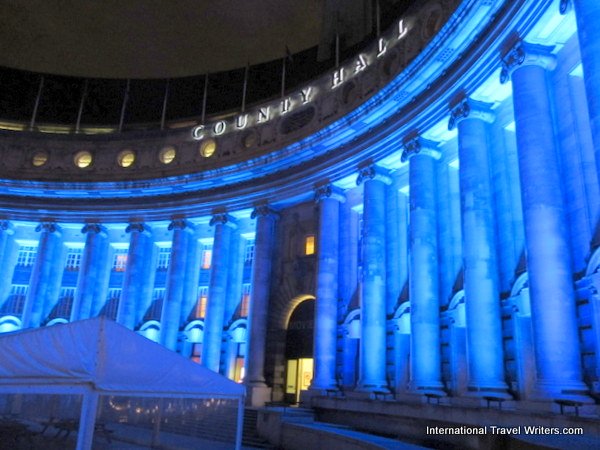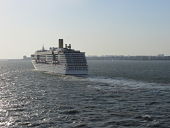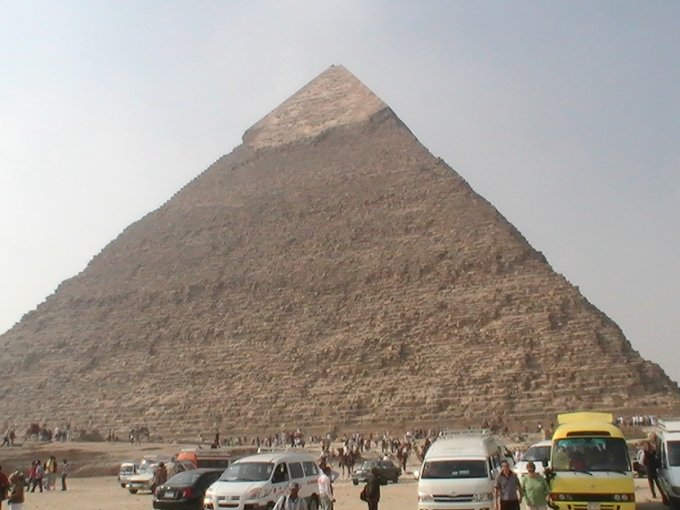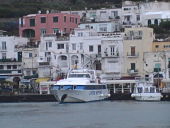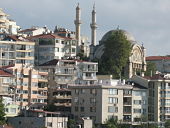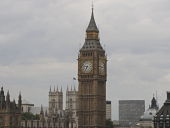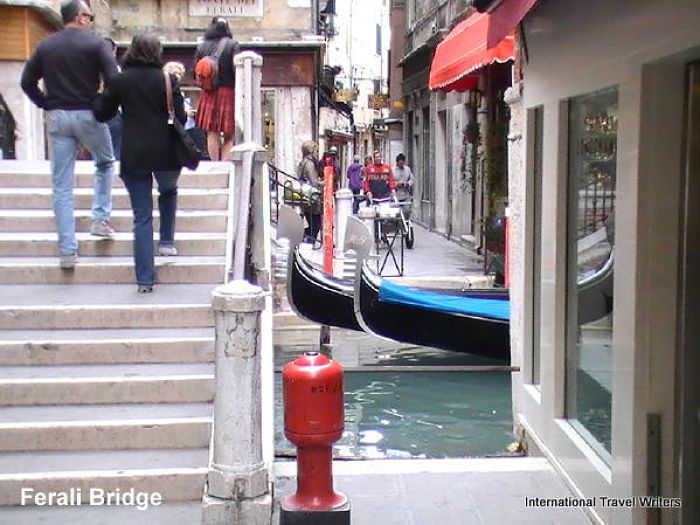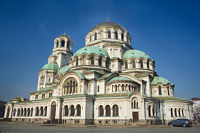London Landmarks

London landmarks appear on numerous streets but there is an abundant concentration of statues occupying Trafalgar Square which is itself an extraordinary landmark. One of the four British Lions at the foot of Nelson's Column is seen above.

The regal king of Landmarks, Trafalgar Square, is like a throbbing heart beat in the center of London.

Magnificent, over-sized, sculpted lions at the foot of Nelson's Column in Trafalgar Square

Trafalgar Square - the rear plinth holds a statue of King George IV wearing ancient Roman attire and riding bareback. Other London landmarks nearby...in the foreground is Sir Henry Havelock, placed in honor of his exploits during the 1857 Rebellion in India. A third plinth (not visible here) holds a statue of Sir Charles Napier who also earned renown in India.
Note: In the U,K. they use the architectural name "plinth" for the base or platform upon which a column, pedestal, statue or monument rests.

St. Martin-in-the-Fields is located in the north-eastern corner of Trafalgar Square. Although it is small and unassuming it has solid ties to the Royal Family because it is the parish church of Buckingham Palace. It has humbly joined the ranks of the London landmarks.

"Justice" by Hibbert Binney is a scale and sword rooftop statue looking outward from above Piccadilly on the corner of James Street is certainly another of the London landmarks.

London landmarks...Big Ben, Westminster Abbey, Houses of Parliament, Westminster Bridge over the River Thames.

The Wellington Arch Quadriga sculpture in honor of King Edward VII is one of the major London landmarks. It shows a quadriga with the angel of peace descending on the chariot of war. It is led by a small boy. The arch is at Hyde Park Corner amongst heavily trafficked streets. Streets that converge at this particular corner include Park Lane, Grosvenor Place, Piccadilly, Knightsbridge and Constitution Hill.
The original statue placed on the top of Wellington Arch in 1846 was of the 1st Duke of Wellington (Sir Arthur Wellesley) but it was constantly criticized for its looks and eventually replaced and moved to another location in 1912.

Windsor Castle has been occupied longer than any other palace in Europe. The original castle was built in the 11th century after the Norman invasion by William the Conqueror. It has been used by succeeding monarchs since Henry I. It has been remodeled numerous times over the centuries, most recently in 1992 after a fire, and is today still used as a weekend retreat by the Royal Family.

This member of the London landmarks (Windsor Castle) covers more than 13 acres and is a fortification, a palace and some would say, a small town. Queen Victoria and Prince Albert made it their primary royal residence and Prince Albert died in the Blue Room there in 1861.

Windsor Great Park is a large deer park of 5,000 acres on the border of Berkshire and Surrey. Formerly the private hunting ground of Windsor Castle, it dates from the mid-13th century.
Seen in the distance is the 1829 Copper Horse statue of King George III. He is resplendent in the style of a Roman emperor riding stirrup-less on his horse atop Snow Hill in the Great Park. The Long Walk to the statue measures around 2.65 miles from George IV Gateway at Windsor Castle.

London landmarks include what is called "The Mall". It isn't a huge shopping center as some would assume by the name but a road. Hundreds of years ago it was a dusty and bumpy track to St. James's Palace that was named after a French game ...Paille Maille that a king played up and down the dirty track. When Queen Victoria moved the royal residence to Buckingham Palace it was simply called "The Mall". It is actually a processional route from Buckingham Palace to the Admiralty Arch...and after passing through the arch it ends at the opposite end of the Palace...Trafalgar Square.

On the road that leads from Piccadilly to Green Park there is a set of gates that exhibit a Sphinx on the top of each gate post. They are done more in a Greek style than the Egyptian version, and they are females.

The colossal statue of Achilles (18 feet tall) is produced from melted enemy cannon that were captured from the battles of Salamanca, Vittoria, Toulouse and Waterloo. It shows the Greek mythological hero raising his shield with his left hand while holding his short sword in his right hand. His cloak drapes over his shoulder

The Achilles sculpture was a dedication to the Duke of Wellington by King George III in 1822.

King George III statue at Pall Mall, London. He ruled from 1760 to 1820.

This is a sculpture "Running of the Green", depicting Pan playing his flute, propelling a family (mother, father, child and dog) forward in a run towards Hyde Park. It is located near Edinburgh Gate and was unveiled in April, 1961.

Horse Guards Parade is the large open space that lies at the eastern end of St. James Park and is considered one of the London landmarks. One side lays open to the park and the other enters Whitehall. The parade ground itself is bordered by historical buildings and the iron-gated entrance to Downing Street. It is also home to many statues of military generals, including Lord Kitchener and Lord Mountbatten.
 |
 South Africa Gate has a post (seen on the left) holding a boy with a blank shield at the south end while a boy holding a shield with the West Africa crest is on the north side. |
The Changing of the Guard takes place at 11:30 on the Buckingham Palace forecourt and lasts approximately 40 minutes. The Household Cavalry has barracks that still house around forty mounted sentries of the Royal Guard used to defend the Queen at the other end of the Mall. There are two regiments: the Life Guards (red coat and white-plumed helmet) and the Blues and Royals (blue coat and red-plumed helmet) You can see two on either side of the gate and they change around every hour between 10 a.m. and 4 p.m.

Ritz Hotel...Piccadilly's grand hotel for over a century has an interesting history and should be included in London landmarks. It was opened in May of 1906 by Swiss hotelier Cesar Ritz (dismissed former manager of the Savoy Hotel). Alongside him was the world-famous chef Escoffier to provide exquisite cuisine to match the hotel’s opulence. Their “Palm Court” hosted such notables as King Edward VII, Queen Elizabeth-the Queen Mother, Judy Garland, Sir Winston Churchill, Noel Coward, etc. They now have a high stakes casino in the basement of the hotel called “The Ritz Club”. The hotel is neoclassical in a Louis XVI style.
Over the years with shifts in the economy the hotel went through different ownerships culminating with the purchase by David and Frederick Barclay in 1995. After 8 years and 40 million pounds it was restored to its former grandeur. It became the first hotel to receive the Royal Warrant from his Royal Highness the Prince of Wales for banqueting and catering services in 2002.
UPDATE: Former British Prime Minister Margaret Thatcher died at the Ritz Hotel aged 87, after a stroke on April 8th, 2013.

The Fourth Plinth in Trafalgar Square was unused because an intended statue was never mounted. Since 2005 temporary works have been commissioned to occupy the space so that the works of contemporary artists can be displayed. The bronze sculpture seen above, a boy on a rocking horse, is called "Powerless Structures". It was created by a Scandinavian duo. The other 3 plinths are permanent: King George IV, Major General Sir Henry Havelock, and Charles James Napier.
Rumor has it that a statue of Queen Elizabeth II, mounted on horseback, will be placed there permanently when she passes.

Charing Cross Station: Charing Cross, or Queen Eleanor's Cross, is the large monument that stands just outside the train station. It was built by Edward Barry in 1865 and represents one of the 12 crosses that were erected by King Edward I. The original location was actually where Trafalgar Square is now located (statue of Charles I is now placed on that spot).
When Queen Eleanor died in 1290, her body was taken to London from Nottinghamshire. The King was so distraught at her passing that he erected a cross at every place the funeral train stopped. The last stop was on the bank of the Thames and was named Charing Cross. It is believed it was named after her because "chere reine" means dear queen. Although the old one was demolished in 1647, a new cross was built at the same time as the station.

MARBLE ARCH – another member of the London landmarks, was designed in 1827 by John
Nash and was fashioned after Rome’s Arch of Constantine (built in the 4th
century) with a large central arch and a smaller arch on each side. The
original arch was embellished with multiple statues that have been moved
elsewhere, the most notable was of King George IV which sat on the top of the
central arch.

Sculpted reliefs found at the top of the arch represent England, Scotland and Ireland. It was meant to be a triumphal gateway to Buckingham Palace but in 1851 the arch was moved to the current site (northeast corner) of Hyde Park because Queen Victoria requested its removal. The reasons given are conflicting (too narrow for coaches to pass through, more space needed, hated the view being blocked, etc.)

St. Paul's Cathedral has been rebuilt numerous times on the same site. 675 AD...burned down. 962 AD...sacked by Vikings. 1087 and 1136...more fires. 1561...lightning strike. 1666...Great Fire of London. The current St. Paul's Cathedral was completed in 1708 and has the second largest dome in Europe (St. Peter's in Rome is larger). This is where, in 1981, Diana married Prince Charles.

St. Paul's, a member of the London landmarks, has what is called "the Whispering Gallery", named because what is spoken quietly on one side is heard 107 feet away on the other side because of superb acoustics. You can climb the 257 steps to enjoy the views from there but, "you are better man than I, Gunga Din" if you manage that trek! For the very intrepid...climb another 119 steps to the Stone Gallery...another 150 steps to the Golden Gallery...and through a small hole in the center of the very highest dome you can have a dizzying view of the cathedral floor below.

St. Paul's Cathedral contains the largest crypt in Europe with over 300 memorials...Lord Nelson (his sarcophagus is carved from the wood of a beaten French warship), Duke of Wellington (his coffin has the banners from his funeral hanging around its sides), Christopher Wren, Florence Nightingale, Lord Kitchener and many more.
 Queen Anne statue in front of St. Paul's Cathedral |
 The nearby Dunstan Chapel |
Anne was Queen when St. Paul's was built. She is seen in front of the Cathedral holding a golden orb and scepter, both gilded. The weather-beaten statue of 1712 was replaced with a replica in 1885. There are figures at the base (not shown here) representing England, Ireland, France and North America...all the territories that she laid claim to. The Royal Coat of Arms of the time has the French Fleur-Di-Lis along with the Irish Harp and English Lions.

London landmarks at dusk...Victoria Tower on the left, Elizabeth Tower (Big Ben) on the right and Houses of Parliament in between.

In front of the Houses of Parliament (Palace of Westminster) is the equestrian Statue of King Richard I (the Lion Heart) wearing a mail shirt and lifting a sword into the air was installed in 1860. Bas-relief panels showing the Battle of Ascalon and Richard pardoning Bertran de Born were added in 1866.

London landmarks...closer view of King Richard I

Westminster Hall is the oldest surviving part of the Parliament Buildings. It was built by William the Conqueror's son in 1097 after moving his royal residence from the Tower of London. Most kings followed suit for 450 years, until Henry VII built St. James's Palace in 1530.
The Hall is fronted by an imposing statue of Oliver Cromwell (placed there in 1899). It was here that Cromwell was sworn in as Lord Protector in 1653. The likeness shows him holding a bible and a sword. Opinion has it that he was more of a military dictator than a protector.
The Hall served as the country's highest court until the mid-19th century, hosting trials of Charles I, Anne Boleyn, William Wallace and the famous Guy Fawkes who was tried for treason in the Gunpowder Plot. The last time the hall was used for ceremonies or coronation banquets was last in 1821 when George IV took the throne.
These days it is used mainly for funerals, when England's hand-picked elite are laid in State...such as Winston Churchill in the sixties and the revered Queen Mother in 2002.

The statue of George V is placed in Old Palace Yard, Westminster. He was King of the United Kingdom, the British Dominions and Emperor of India. Although the statue was sculpted prior to WW2 it was hidden in a quarry during the war years. It was unveiled by George VI in 1947. It is made of Portland stone and stands 10 feet high. (Old Palace Yard is located south of Westminster Chapel and opposite the House of Lords).

Hyde Park Corner Screen sits on a separate traffic island, between Piccadilly Arcade and Hyde Park. It is a 107 foot wide gate with 3 arches connected by an Ionic colonnade. It was designed in 1825 as an entrance to Hyde Park and is one of the most striking London landmarks.

Apsley House sits next to the Hyde Park Screen and was once the home of the Duke of Wellington (Arthur Wellesley). Today it is a museum dedicated to the Duke...it contains a collection of paintings from masters along with furniture that belonged to him. A notable work of art is a 10 foot tall statue of a nude Napoleon.

The National Monument to the Women of World War II is a war memorial structure situated in Whitehall. It is one of the newer London landmarks and it was unveiled by Queen Elizabeth II on July 9, 2005. The monument stands 22 feet high and is 6 feet wide. There are 17 different sets of clothing and uniforms around the sides, symbolizing the multitudes of jobs performed by women during the war and although a newcomer it has gained status as one of the London landmarks.
Baroness Boothroyd raised a goodly portion of the funds to build it on the ITV game show Who Wants to Be a Millionaire? Joining the fundraiser trust were notables Dame Vera Lynn and the Princess Royal.

Another war memorial can be seen just beyond, past the traffic light, The Cenotaph is built from Portland stone and was placed there permanently in 1920, replacing a temporary one meant to honor peace following the end of WWI. The site is the location of the official annual National Service of Remembrance held on the Sunday closest to November, 11th... Armistice Day.

King's Reach Memorial is located on Temple Pier. It is dedicated to George V and commemorates the naming of this stretch of the river after him. It's called a stele (an ancient upright stone slab) with a plaque and sculptures that was unveiled January 20, 1936.
 Royal Artillery Memorial at Hyde Park Corner dedicated to WWI casualties. Howitzer on the top with stone reliefs showing scenes of the conflict. |
 Field Marshal Earl Haig, Commander-in-Chief of the British Armies in France 1915-1918. It is on Whitehall, Westminster near the entrance to Horse Guards Parade. Unveiled Nov. 10, 1937 |

Parliament Square has another of the London landmarks, Victoria Tower. The tower is slightly taller than Big Ben (Elizabeth Tower) and it stands at the House of Lords end of Palace of Westminster. The main entrance at the base is the Sovereign's Entrance where the Monarch passes at the State Opening of Parliament.
Victoria Tower was built as a fireproof repository for books and documents after the fire of 1834 destroyed numerous records from the House of Commons. The first stone of the Tower was laid by Queen Victoria in 1843 and construction was completed in 1860.

Victoria Embankment starts at Westminster Bridge then follows the course of the north bank, past Hungerford Bridge and Waterloo Bridge, before ending at Blackfriars Bridge in the city. It is part of the Thames Embankment, a road and river walk along the north bank of the River Thames in London and qualifies to be one of the London landmarks.
London boat services operate from Westminster Millennium Pier, Embankment Pier and Blackfriars Millennium Pier at points along the Victoria Embankment. Pleasure cruises also operate from Savoy Pier.

From this viewpoint you can see the OXO Tower on the right. It sits on the south bank of the River Thames. It has been redeveloped for mixed uses such as arts and crafts shops on the first few floors and a restaurant on the eighth floor (floors two through seven are flats) so its now called "Oxo Tower Wharf". Originally built as a power station towards the end of the 19th century it was then acquired by the manufacterers of Oxo beef stock cubes, hence the tower name.

Albert Bridge is the crossing over the River Thames between Chelsea and Battersea, another of the London landmarks. It's named in memory of Queen Victoria's Prince Consort. Completion was in 1872. It's a rigid suspension bridge that measures 710 feet long and 41 feet wide. About 10 years after its completion it was strengthened and its outward appearance morphed, reflecting the appearance more like a cable-stayed bridge. After WWII there were plans to replace it but Londoner's fought to keep it. Central supports were then added to support the additional traffic and weight restrictions were imposed.

Battersea Park's Temple of Peace, another of the London landmarks, is a 110 foot high structure built in 1985 by Buddhist monks. Historical Battersea Park is 200 acres and originally opened back in 1858. In 1861 its Pump House Gallery was established. It now has 4 floors exhibiting contemporary art exhibitions and it's also popular for weddings.
Until 1977 Battersea Park even had a Big Dipper Roller Coaster but today there are playgrounds and a children's petting zoo for the youngsters while for others there are cricket pitches, tennis courts, jogging trails and you can either rent or bring your own bicycle to enjoy the park's bike paths. The park has a large lake where you row a boat or use pedal boats, even fish if you obtain a permit.

London landmarks include Fleet Street. Temple Bar sculpture is in the center. It displays a dragon on the top. This is the point in London where Fleet Street, City of London becomes the Strand, Westminster. This was a barrier that functioned to regulate trade into the city. The Royal Courts of Justice are located nearby.
It has been a long standing custom for the monarch to stop at Temple Bar before entering the City of London, so that the Lord Mayor could offer the City's Sword of State as a token of loyalty...like being presented with the keys to the city.

The London Eye nearby Old County Hall
 |
 |
The London Eye started out being called the British Airways London Eye and that seemed like a cool name (mainly because we love flying British Airways) but over time this changed due to ownerships and sponsorships.
This giant Ferris wheel (443 feet tall and with a diameter of 394 feet) has 32 sealed and air-conditioned passenger capsules that hold up to 25 persons who are free to walk around although seating is provided. It was formally opened (by then Prime Minister Tony Blair) on December 31, 1999 as the Millennium London Eye.
It is interesting to note the "Great Wheel" was a predecessor, built for the Empire of India Exhibition at Earls Court that opened to the public in July of 1895 (308 feet tall and diameter of 270 feet) with 40 cars holding 40 persons stayed in service until 1907.
Related Articles......
Return from London Landmarks to International Travel Writers Homepage
Having trouble finding what you need? International Travel Writers Index and Map
OR
Do you have a travel experience or story to share? Share your travels here!
By Carolynne Woods, © Copyright 2010-2020. International Travel Writers.com All rights reserved images and text

